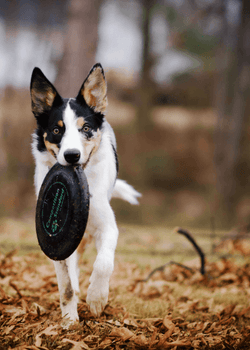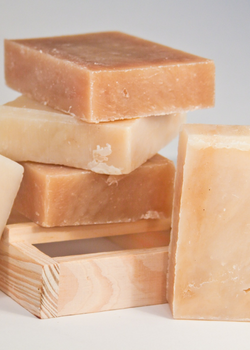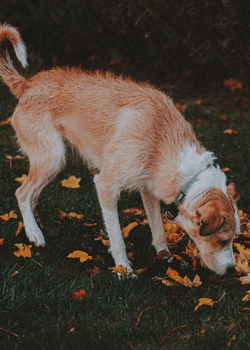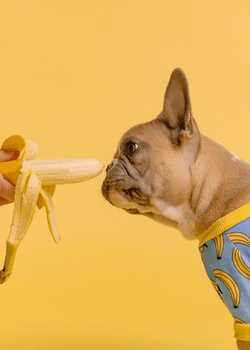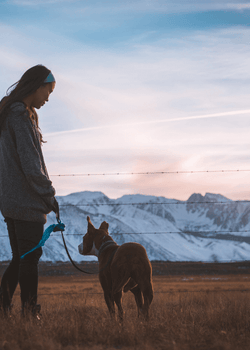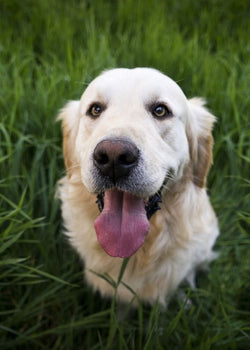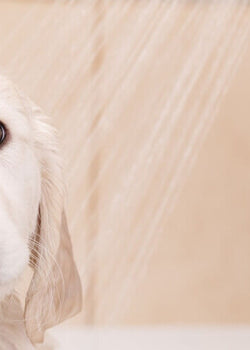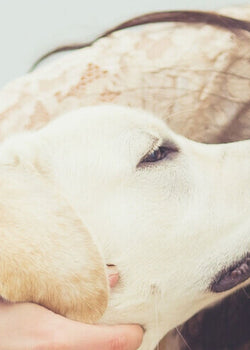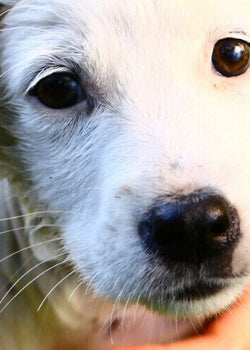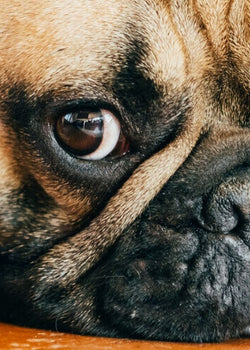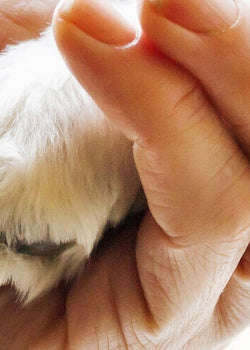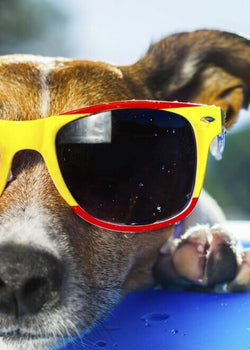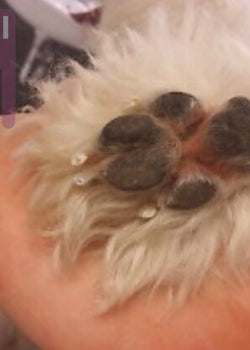Recipe: Natural soap for dogs
If you like natural products and if you also like to create, you must have thought about making natural soap for your dog at home.
Before starting to make soap, it is good to know which ingredients are suitable for our pets and what role they play. For example, if your pet has problems with itchy and irritated skin, you can add oatmeal to the soap, which soothes the skin.

We have prepared a recipe for homemade dog soap for you, which you can adjust to your own preferences with the help of the calculator .
What we need to know about pH
The pH of a dog's skin is about 7.5 and ours is about 5.5, on the standard pH scale of 0 to 14. The pH scale measures how acidic or basic a substance is and the closer it is to 7, the more neutral the substance is (eg pure water has a pH of 7) .
Dog skin is very close to pH neutral and significantly more basic than human skin, so the type of shampoo you use on your dog should be much more pH neutral.

Over time, acidic shampoos also remove the hair's protective properties by stripping the hair and skin of valuable oil, which can lead to dry and irritated skin.
So, one thing you don't want to use on dogs is human shampoo. Our shampoos do not have the right pH for our pets and can therefore cause skin irritation.
If it happens that you don't have shampoo for your furry friend at home and you have to wash it, you can add some ingredients to your shampoo to adjust the pH and thus make the shampoo more suitable for your dog.
RECIPE: SOS shampoo for dogs
Ingridients:
- 90ml of water
- 20g aloe vera gel
- 1 teaspoon of baby shampoo
- 2 drops of lavender essential oil
Mix all the ingredients together well and scoop it with this. Rub well and rinse thoroughly with water. Be careful not to get the shampoo in your eyes.
How often should I bathe my dog?
Avoid bathing more often than is really necessary.
Some shampoos can dry out or irritate a dog's skin more than others. If you notice that your pet does not like the shampoo or soap, change it as soon as possible.
Basically, the best way to tell when your dog needs a bath is to smell it. Doesn't it smell too nice? Is it dirty/muddy? Then go straight to the shower.

Bathing your furry friend once a month or not is usually enough. Of course, if your dog likes to bathe, is obsessed with mud puddles or likes to roll around, you will need to bathe him more often, but it is still not good to overdo it.
Bathing your dog too often can strip the coat of its natural oils, causing dry skin, dandruff and itchiness.
Here are some guidelines that can help you if you are not sure how often you can bathe your dog:
- Bathing once a month is sufficient for most dogs.
- Some dogs with oily hair may need to be bathed once every two weeks (eg Newfoundland).
- Many short-haired, smooth-coated breeds do well with infrequent baths.
- Breeds with water-repellent coats (eg Golden Retrievers) need to be bathed less often to preserve their natural oils.
- For dogs with large and long hair, less bathing and lots of extra brushing works best, as this removes excess, dead hair and helps distribute the natural oils that keep the skin and coat healthy
Does my dog need conditioner?
A healthy diet, hydration and regular grooming are important for healthy skin and coat. The secret of shiny fur and moisturized skin can be hidden in the use of a good conditioner for your dog.
Read more about natural dog hair care --> here
The sun, licking, chewing, dirt, bad weather, sand, as well as other external influences and allergens affect the health of a dog's skin and coat. A coat that is in good condition produces its own natural oils that are distributed along the hair shaft, giving your dog a natural shine and allowing debris and dead hair to slide off.

Therefore, skin and hair that are in good condition and properly lubricated become more resistant to parasites, infections and external allergens. While the dry coat and skin hold debris and dead hair, causing irritation and itching.
Healthy skin = healthy coat
In addition, if you have a dog with longer hair, the conditioner can be a great help when combing, because the hair will not get tangled and stuck.
Of course, the use of conditioner is not necessary for every dog. To determine if using conditioner would be beneficial for your dog, consider the following:
- How long is your dog's hair?
- How often do you wash your dog?
- Does your dog have itchy skin?
1. Long hair
If your dog has longer hair (breeds such as Maltese, Yorkies, etc.) there is a greater chance that his hair will become tangled. Using conditioner will not only make combing and grooming your dog easier, but it will also make it easier to remove knots and tangles, making brushing after bathing a 'little snack'.
2. Frequency of bathing
If you bathe your dog more than once a month, consider using a conditioner, as this will prevent the skin and coat from drying out.
3. Itchy skin
A dog that has problems with itchy skin is usually bathed more often, as the appropriate shampoo relieves itching and washes away allergens. However, frequent bathing can lead to more itchy skin if we do not take care of moisturizing. So, using a balm helps to moisturize while also softening and soothing dry, itchy skin.
Essential oils for dogs
Some animals, such as cats and rabbits, are very sensitive to essential oils. In dogs, however, the use of essential oils is common and in most cases harmless. There are many essential oils for dogs that you can safely use and that also have wonderful benefits for them. In addition, it is good to know that there are also essential oils, which should be avoided, as they are harmful to dogs.

Essential oils that are safe for dogs:
- Lavender
- Cedar
- Geranium
- Chamomile
- Lemon grass
- And much more
Essential oils that are harmful to dogs:
- Tea tree
- Juniper
- Cinnamon
- Oregano
- Birch tree
- Citrus
- …
When choosing essential oils for soap, it is good to keep in mind what we want the soap to serve. For example: we can choose essential oils that repel insects, a light essential oil that helps to calm the skin, or just an essential oil that will leave the fur smelling as pleasant and fresh as possible.
Dog shampoos/soaps: the power of ingredients
Neem oil
Neem oil is antibacterial, antifungal and repels insects. It is an ideal ingredient for dog soap, as it helps to clean skin impurities and wounds, while also repelling fleas, ticks and mosquitoes.
Castor oil
Castor oil creates more foam in the finished product than other oils.
Oatmeal
Oatmeal in soap has health benefits for many skin conditions and ailments. Oatmeal soap is effective in treating rashes, insect bites, itchy and dry skin.
Apple cider vinegar
Vinegar lowers the pH of the soap from around 9 to around 8. Soap is never neutral, but if you add a little vinegar to it, you can get a bit closer to neutrality. However, letting the soap dry for 6 weeks or more will also help lower the pH.
A mixture of essential oils against insects
Lavender: Great for almost everything... Lavender is especially good for the skin and repels fleas and mosquitoes.
Peppermint: Fleas don't like the smell of peppermint, and it also leaves your dog smelling fresh.
Cedar : Mixes well with other oils, repels fleas and mosquitoes.
Geranium : Great for repelling insects.
Well, now let's get to work...
RECIPE: Homemade Natural Soap for Dogs
Percentage of 'super fats': between 5% and 6%
This recipe is enough for about one 800g model.

Ingridients:
- 190 g of distilled water
- 70 g of lye (sodium hydroxide – NaOH)
- 200 g of olive oil
- 150 g of coconut oil
- 75 g of rapeseed or sunflower oil
- 50 g of neem oil
- 25 g of castor oil
- 2 g of lavender essential oil
- 2 g of peppermint essential oil
- 2 g essential oil of cedar
- 2 g of geranium essential oil
Instructions:
- Put on safety glasses and gloves before working with lye. This is just a safety measure, as lye is caustic and can cause burns.
- Weigh the lye and especially the water in a glass or ceramic container
- Add lye to a bowl of water (and not the other way around!).
- Mix the lye and water well until the lye is completely dissolved. You will notice that it warms up and becomes more cloudy at first, then clears as it cools. Keep the mixture out of the reach of children, animals or anyone else.
- Weigh all major oils (olive oil, coconut oil, neem oil, canola oil and castor oil - but not essential oils) on a kitchen scale. If the particular oil is in a solid state, heat it first and liquefy it.
- Add the lye solution to the oil and mix gently with a spatula.
- Then start mixing gently with a stick blender. When the mixture thickens (the consistency of pudding) and the mixer leaves marks on the surface, it means that the oils have mixed with the lye solution.
- When you get to this "pudding" stage, you can add essential oils, and if you want to increase the % of "super fats", you can save a gram of oil and add it at this stage as essential oils.
- Pour the mixture into the mold.
- Cover the soap with a towel and set it aside to set for a day or two.
- Check the soap from time to time and uncover it, but when it seems hard enough you can take it out of the mold.
- Cut it into desired pieces.
- Place the sliced soap on a cardboard base and wait at least 4 weeks for it to mature. During the ripening process, all the lye is leached out of the soap, and in the end it remains a completely natural, safe and high-quality soap for your dog.
But if you don't want to deal with lye, you can also buy casting soaps. With these soaps, someone else has already done the maturation and work with the lye for you. You just dissolve the selected base and add additives as desired, for example oatmeal, a selected mixture of essential oils, marigold flowers or something else.
Bathing the dog
1. Brushing
Brush the dog before bathing. This will remove excess hair and knots that hold water and can cause skin irritation.
2. Lukewarm water
After brushing the dog, first wet it and rinse it with lukewarm water.
3. Soap it up with natural dog soap
Gently rub the soap over your pet's fur to create a lather. When you have got enough foam, massage it all over your body with your hands.

4. Rinse well
Rinse the soap off the dog very well. If some soap remains on the skin, it can cause irritation.
5. Balm (optional)
If you have decided to use the conditioner, now is the time to apply it and rinse thoroughly.
6. Air drying
Do not use your hair dryer on your dog, as their skin overheats much faster than ours and can burn them. Just rub them with a towel and then let them air dry.
What should I do if my dog refuses to bathe?
If bathing is not your dog's favorite activity, you can help him to accept it more easily.
- Let your dog know it's bath time. Always use a specific word before it, for example "bathing". With this, you are helping the dog, because he knows what is coming, so it is not too much of a surprise for him. Even if the word causes them to hide, at least they know what it means and what's coming.
- Lure him to you with treats. Avoid chasing because you don't want the dog to run away from you.
- Bath time should always be related to something your dog likes. You can reward him with a treat in the tub if he stays there. But he can have one toy that is only available to him in the bathtub. After a successful bath, upgrade your pet again with a treat.
- Use lukewarm water and if your furry friend is very slippery in the tub, place a non-slip pad on the bottom.
- Do not pour running water over your dog's face. Use a wet cloth on this area.

Our pets are a wonderful part of the family and we usually treat them like a real family member. So don't forget about care... When you're thinking about applying something natural to your body, think about your pets as well, because they're often more sensitive to these things. Get the best of nature, even for them. 😊


